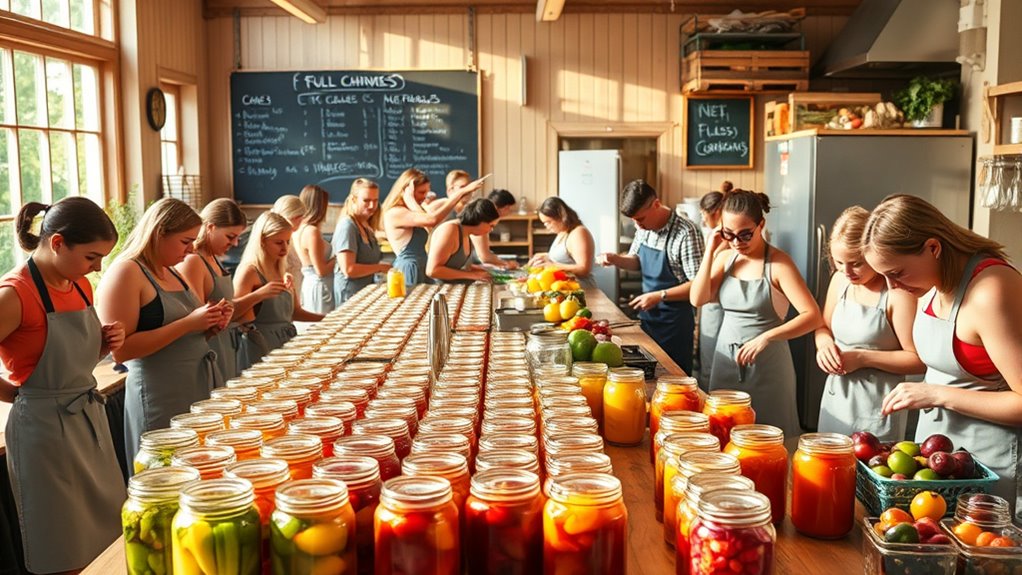As food prices rise, you’re not alone if you’re considering canning classes. More people are enthusiastic to learn this invaluable skill for budget-friendly meal preservation. Community classes are filling up as participants gain hands-on experience and connect with others. You’ll find that canned goods offer both nutritional benefits and a way to control ingredients. Plus, there’s something rewarding about preserving your own food. If you’re curious about what else it offers, there’s plenty more to explore.
Key Takeaways
- Rising food prices are prompting individuals to seek canning classes as a budget-friendly food preservation solution.
- Canning allows participants to buy seasonal produce in bulk, significantly reducing grocery expenses.
- Community canning classes foster connections and provide hands-on training in safe canning practices.
- Home canning promotes self-sufficiency and minimizes waste, appealing to those facing economic uncertainty.
- Increased interest in canning supports local food movements and enhances community engagement.
The Resurgence of Canning: A Historical Perspective
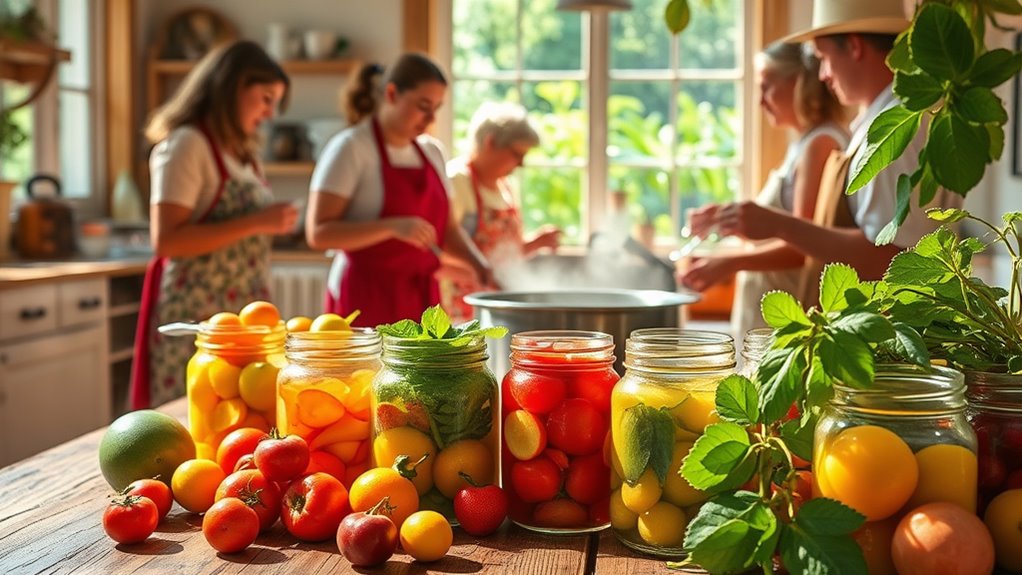
Canning, which has roots dating back to the early 19th century, has seen a remarkable resurgence in recent years.
It all started when Napoleon offered a reward for a new food preservation method in 1795, leading Nicolas Appert to develop the first practical canning method in 1809. By 1810, Peter Durand introduced the first tin canister, and Robert Ayars opened the first cannery in the U.S. in 1812.
The introduction of the Mason jar in 1858 revolutionized home canning. Over time, technological advancements improved canning safety and efficiency, making it a staple in American homes.
Home canning traditions, often passed down through generations, foster a sense of accomplishment and community, creating a lasting cultural significance.
Economic Factors Driving Interest in Canning

As food prices continue to rise, many people are turning to canning as a practical solution to manage their grocery budgets. By buying seasonal produce in bulk, you can notably cut down on grocery bills. Canning allows you to enjoy homegrown fruits and vegetables year-round, promoting self-sufficiency while reducing waste from excess produce. With economic uncertainty on the rise, you’re likely seeking stable, cost-effective food solutions. Additionally, employing a budget plan can help you allocate funds effectively for purchasing bulk ingredients. Incorporating whole foods into your canning process can further enhance the nutritional value of your preserved items. The growing demand for convenient, ready-made options also supports the popularity of canned goods. Plus, as health consciousness increases, more consumers want nutritious, clean-label products. Including butter’s low sugar content in your canned goods can enhance their nutritional value. Furthermore, selecting disease-resistant types of vegetables for canning can ensure better yields and quality in your preserved items. Embracing canning now not only helps you save money but also aligns with your desire for healthier food choices.
Community Learning: The Rise of Canning Classes
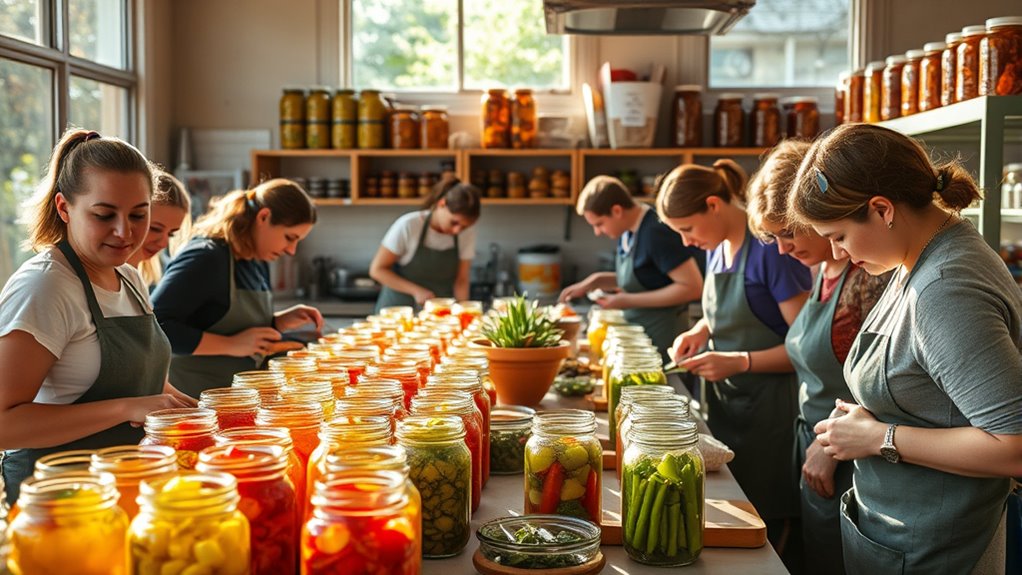
With the resurgence of interest in traditional food preservation, community canning classes are becoming a popular way for people to connect and learn together.
You’re likely to find a diverse group of attendees, ranging from beginners to those with some experience, all enthusiastic to share knowledge and skills. These classes create a structured environment where you can learn safe canning techniques, often taught by local experts or institutions like the University of Illinois Extension.
Many participants rely on friends, relatives, and cookbooks for guidance, emphasizing the importance of community engagement. As you engage in this hands-on learning experience, you’ll not only preserve food but also foster connections with others who share your passion for sustainable practices.
Health Benefits of Home Canning
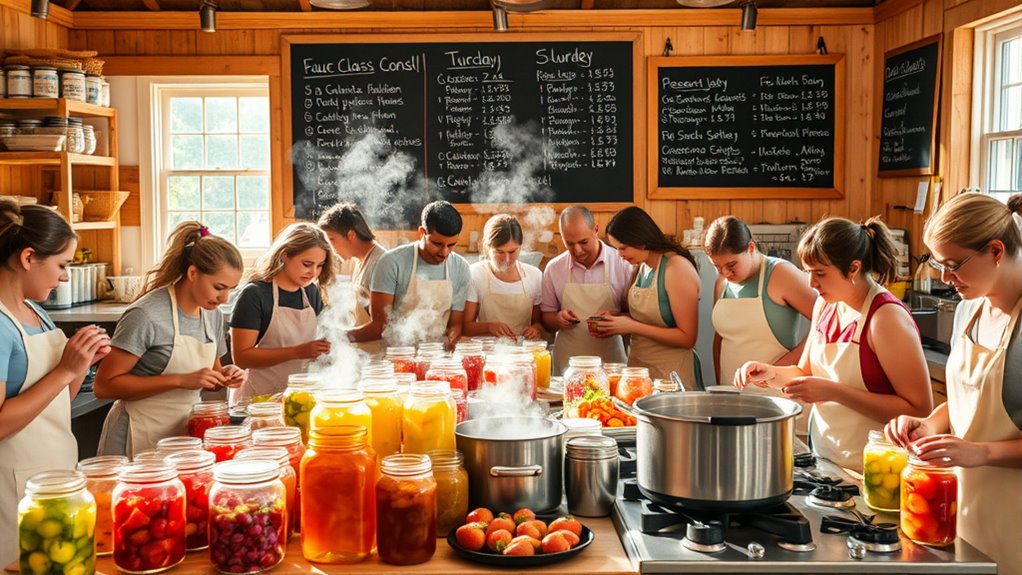
Home canning offers a range of health benefits that make it an appealing choice for those looking to enhance their diet.
You gain complete control over ingredients, allowing you to avoid artificial additives and reduce sugar and salt. By selecting high-quality, organic, or non-GMO produce, you guarantee better nutritional value.
Proper canning techniques help retain essential vitamins and minerals, making your canned goods often more nutritious than fresh produce that’s traveled long distances. Plus, without preservatives, you create healthier meals tailored to your dietary needs.
Home canning preserves vital nutrients, often making your creations healthier than store-bought, long-distance produce.
Embracing home canning not only supports better eating habits but also fosters a more sustainable lifestyle by reducing waste and promoting the use of local foods.
It’s a win-win for your health and the environment!
Embracing Creativity Through Canning
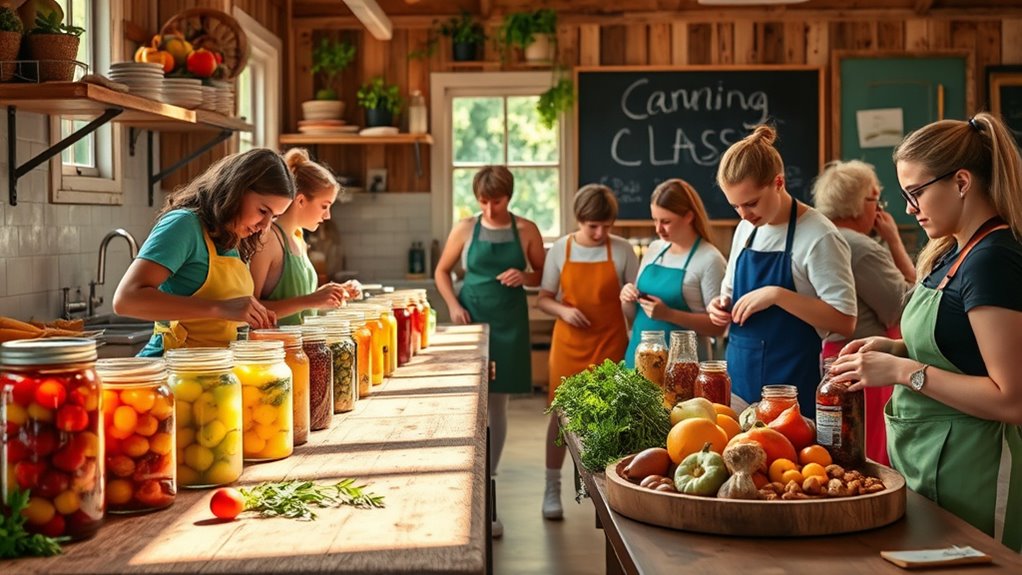
Canning not only promotes healthy eating but also releases your creativity in the kitchen. You can experiment with high-acid foods like jams and pickles, combining fruits such as blackberry and apricot for unique flavors. Additionally, exploring global flavors can elevate your canning game and inspire new recipes. Engaging in this creative process not only nurtures your culinary skills but also fosters personal growth as you learn from each batch you create. Using eco-friendly practices while canning can further enhance your culinary experience and reduce your environmental impact through sustainable harvesting. Freshly squeezed juices, like orange juice, can be a delightful addition to your canned goods, providing freshness and flavor to your creations.
Pickling various vegetables, like carrots and daikon, allows you to express your culinary flair. Incorporating seasonal produce from farmers’ markets supports local agriculture while giving you fresh ingredients for your creations.
Try out water bath canning for easy experimentation, or even blend canning with fermentation for exciting textures. Additionally, embracing sustainable practices in your canning process can enhance the quality of your food while minimizing environmental impact.
Don’t shy away from adapting traditional recipes from different cultures or using heritage ingredients. By embracing creativity through canning, you not only produce delicious goods but also connect with your community and its culinary heritage.
Social Media’s Role in Popularizing Canning

As social media platforms continue to evolve, they’ve become vital in popularizing canning among a new generation of enthusiasts.
With viral campaigns from brands like Heyday Canning and engaging hashtags on TikTok and Instagram, millions are discovering the joy of preserving food. Influencers play a significant role, sharing their experiences and recipes while promoting safe practices.
Viral campaigns and influencers on social media are igniting a passion for food preservation among millions.
This cultural revival taps into a desire for traditional skills, especially during economic uncertainty. Social media fosters community engagement, allowing you to share recipes and tips with fellow canners.
Challenges and competitions spark creativity, while educational content guarantees you have access to safe canning methods. Ultimately, social media is transforming canning into an innovative and accessible hobby for all.
Psychological Rewards of Food Preservation

The satisfaction gained from food preservation goes beyond just the act itself; it taps into deeper psychological rewards that enhance your overall well-being.
When you preserve food, you gain a sense of accomplishment and control over your food sources, boosting your self-confidence and independence. This process can also evoke feelings of security, reducing anxiety about food availability. Additionally, incorporating healthy eating habits into your preserved meals can further enhance your overall health benefits. The rise of new Bitcoin holders in the market illustrates how a shift in control can empower individuals in their financial decisions. Engaging in food preservation can also lead to mindful living, which fosters appreciation for quality over quantity. Moreover, the act of creating a functional layout in your pantry after canning can significantly improve your storage efficiency.
Familiar, preserved meals provide emotional comfort, especially during stressful times. Engaging in food preservation stimulates creativity and critical thinking, enhancing your cognitive skills.
Plus, sharing your preserved goods strengthens social bonds, fostering a sense of community. Ultimately, these rewards create a fulfilling experience that enriches your life, making the effort well worth it. Additionally, the process of organizing your pantry after canning can create a clutter-free space, further enhancing your home environment and promoting overall peace of mind.
Safety and Best Practices in Canning
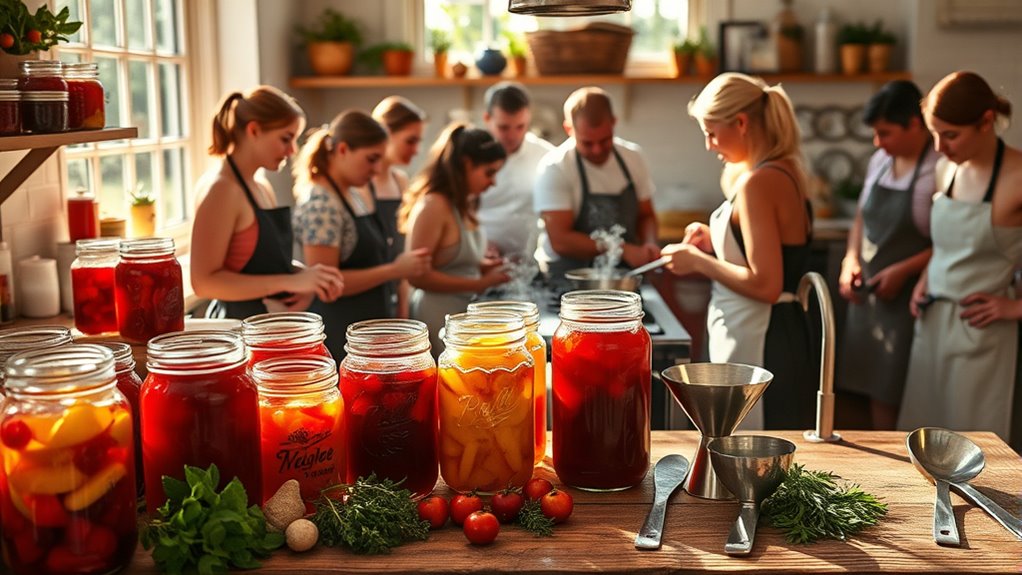
Engaging in food preservation not only brings psychological rewards but also requires a strong focus on safety and best practices to guarantee your efforts yield delicious and safe results.
Use proper jars, like Mason jars, that can withstand high temperatures, and always utilize new self-sealing lids. Choose the correct canner based on the acidity of your food; pressure canners are essential for low-acid foods.
Preheat jars to prevent thermal shock and make certain adequate headspace for a strong seal. After processing, cool jars on a wooden surface, keeping them spaced apart.
Store in a cool, dark place, and regularly check for spoilage signs. Following these guidelines can help you enjoy the fruits of your labor safely.
Looking Ahead: The Future of Canning in a Changing Economy
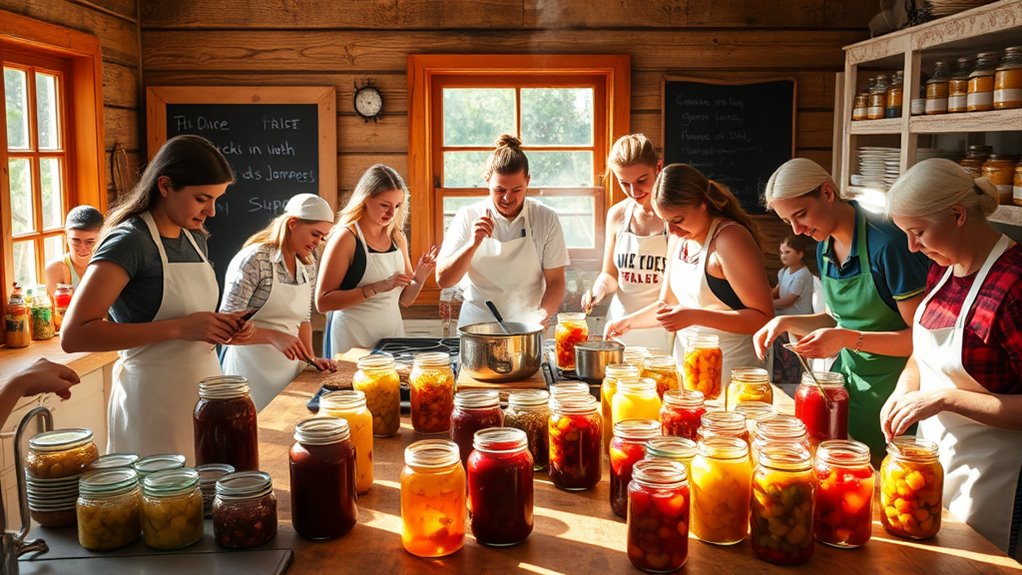
While many people have embraced canning as a method of preserving food, the future of this practice looks promising in a rapidly changing economy.
With the global canned food market projected to grow, there’s a rising demand for convenient, long-lasting options. You’ll find that sustainability plays a key role, as innovations focus on eco-friendly packaging and reducing food waste. Additionally, the emphasis on organic farming methods will likely extend to the canned goods industry, enhancing the appeal of these products.
Canning also presents economic benefits for producers, allowing farmers to stabilize their income and reduce spoilage. As companies explore international markets, exporting canned goods creates new opportunities.
Advances in technology will enhance safety and convenience, ensuring that canning remains a relevant and valuable skill in today’s world. Embracing these trends can position you well for the future.
Frequently Asked Questions
What Types of Foods Are Best for Canning at Home?
When you’re canning at home, focus on both low-acid and high-acid foods.
Low-acid options like asparagus, carrots, and green beans work well, while high-acid choices such as apples and berries are ideal for preserving.
Don’t forget about meats and combination dishes like soups and stews, which can also be safely canned.
Specialty items like jams, pickles, and salsa can add variety to your pantry.
Enjoy the process and get creative!
How Long Does Home Canned Food Last?
Did you know that home-canned foods typically last about a year for peak quality?
When you can your own food, aim to use it within one to two years for the best taste and safety. Acidic foods might spoil sooner, while low-acid options can last longer.
Always check seals and jar conditions; if something looks off, it’s best to discard it. Proper storage in a cool, dry place can enhance longevity.
Can I Reuse Canning Jars and Lids?
Yes, you can reuse canning jars, but you need to guarantee they’re clean and sterilized first.
Check for any cracks or imperfections before using them again.
However, it’s best to avoid reusing canning lids, as they can compromise the seal and lead to spoilage.
Inspect them carefully for damage, and if you’re unsure, opt for new lids to guarantee the safety and quality of your preserved food.
Are There Any Dietary Restrictions for Canning?
When canning, you should be aware of certain dietary restrictions.
Avoid using dairy products, as they can spoil and pose a botulism risk. Don’t can baked goods either, since they might support harmful bacteria.
Low-acid foods require pressure canning to prevent botulism, while high-acid foods can be processed in boiling water.
Always stick to research-tested recipes to guarantee safety and meet dietary needs. Stay informed to keep your canning safe and effective!
What Tools Are Essential for Beginners in Canning?
Did you know that nearly 40% of food produced in the U.S. goes uneaten?
To start canning, you’ll need essential tools like a water bath canner for high-acid foods, Mason jars, and a pressure canner for low-acid items.
Don’t forget a ladle, jar lifter, and bubble remover. These tools help guarantee safety and efficiency, making your canning process smoother.
With the right equipment, you’ll be preserving delicious foods in no time!
Conclusion
As food prices continue to climb, the resurgence of canning reflects a deeper societal shift toward self-sufficiency and creativity. Did you know that home canning can save you up to 50% compared to store-bought goods? By participating in canning classes, you’re not just preserving food; you’re embracing a sustainable lifestyle that resonates with community values. With the right knowledge and passion, you can enjoy both the health benefits and the satisfaction that comes from creating your own pantry staples.

